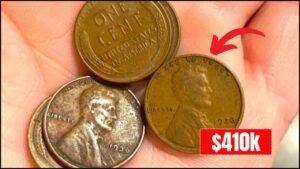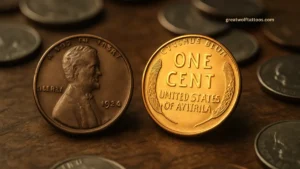Imagine finding a penny in your pocket worth millions! It sounds like a fairy tale, but some rare Lincoln Wheat Pennies can turn this dream into reality. These special coins, especially the 1943 Bronze Lincoln Wheat Penny, are super valuable and might even be hiding in your change jar. Let’s dive into their story, why they’re so special, and how to spot one.
What Are Lincoln Wheat Pennies?
A Bit of History
The Lincoln Wheat Penny was first made in 1909 to celebrate Abraham Lincoln’s 100th birthday. Designed by Victor David Brenner, it was the first U.S. coin to show a real person’s face. The front has Lincoln’s portrait, and the back features two wheat stalks, earning it the nickname “Wheat Penny.” These pennies were used until 1958, when the Lincoln Memorial design replaced them. Most are worth just a cent, but a few rare ones are worth a fortune!
Why Is the 1943 Bronze Penny So Valuable?
A Wartime Mistake
During World War II, copper was needed for things like bullets and wires, so in 1943, the U.S. Mint made pennies from zinc-coated steel instead of bronze. These steel pennies look silver and are lighter. But here’s the exciting part: a few bronze blanks were accidentally used to make pennies that year. Only about 20 to 30 of these 1943 Bronze Pennies exist, making them one of the rarest coin errors ever.
In 2010, one sold for $1.7 million, and in 2021, another was valued at $4.1 million. That’s a lot of money for a penny!
How to Spot a 1943 Bronze Lincoln Wheat Penny
Got some old pennies lying around? Here’s how to check if you’ve got a million-dollar coin:
1. Magnet Test
Steel pennies stick to a magnet, but bronze ones don’t. If your 1943 penny isn’t magnetic, it might be a bronze treasure!
2. Check the Color
Bronze pennies have a reddish-brown color, while steel pennies are silvery-gray.
3. Weigh the Penny
Use a small digital scale. Bronze pennies weigh about 3.11 grams, while steel ones are lighter at around 2.7 grams.
4. Look for Mint Marks
Check for a tiny letter on the front of the penny:
- No letter: Made in Philadelphia
- “D”: Made in Denver
- “S”: Made in San Francisco
If your non-magnetic, bronze-colored 1943 penny has one of these marks, it could be super rare.
Other Valuable Wheat Pennies to Look For
The 1943 Bronze Penny is the star, but other Wheat Pennies can also be worth big bucks:
1909-S VDB Penny
This was the first Wheat Penny, with the designer’s initials (VDB) on the back. Only a few were made, and they can be worth up to $100,000.
1914-D Penny
Minted in Denver, only about 1.2 million were made. Depending on condition, it could be worth $5,000 to $150,000.
1922 No-D Penny
This Denver Mint penny has no “D” mark due to an error, making it worth $10,000 or more.
Where Could These Rare Pennies Be Hiding?
You might be surprised where these valuable coins turn up:
- Old piggy banks or coin jars
- Boxes in your attic or basement
- Garage sales or estate sales
- Coin rolls from the bank
- Family heirloom collections
It’s wild to think someone might have spent a million-dollar penny without knowing!
What to Do If You Find a Rare Penny
Think you’ve found a valuable penny? Here’s what to do next:
1. Don’t Clean It
Cleaning a coin can scratch it and lower its value. Leave it as is.
2. Get It Checked
Take it to a trusted coin dealer or send it to a grading service like PCGS or NGC to confirm it’s real.
3. Sell It Smart
If it’s a rare find, contact an auction house to get the best price from collectors.
Conclusion: Your Pocket Change Could Be a Goldmine
Lincoln Wheat Pennies are more than just coins—they’re pieces of American history. While most are worth just a penny, a few rare ones, like the 1943 Bronze Penny, could make you a millionaire. So, the next time you find some loose change, take a closer look. You might just discover a treasure hiding in plain sight!



